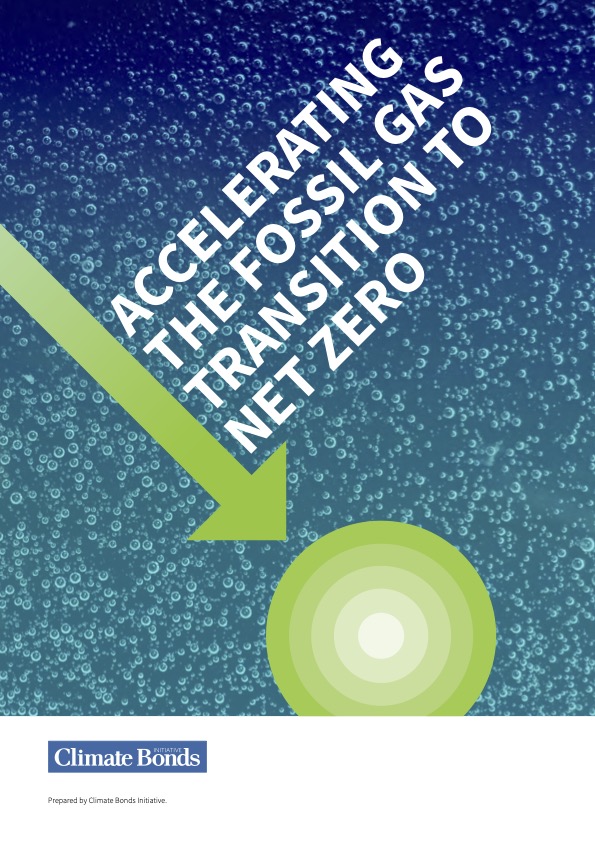'Accelerating the Fossil Gas Transition to Net Zero' policy paper now available
 Today, Climate Bonds released a comprehensive policy paper on fossil gas: its effect on global decarbonisation efforts and how policymakers can enable the transition away from fossil gas. The paper provides a science-based examination of the risks and hidden emissions of fossil gas infrastructure and investments, providing key policy recommendations on how these risks can be avoided.
Today, Climate Bonds released a comprehensive policy paper on fossil gas: its effect on global decarbonisation efforts and how policymakers can enable the transition away from fossil gas. The paper provides a science-based examination of the risks and hidden emissions of fossil gas infrastructure and investments, providing key policy recommendations on how these risks can be avoided.
‘Accelerating the fossil gas transition’ is available now on the Climate Bonds website.
Currently, efforts are underway to include fossil gas investments on the list of sustainable activities laid out in the EU Taxonomy. This paper demonstrates how fossil gas hinders efforts to meet climate targets and weakens global decarbonisation efforts, undermining the Taxonomy’s credibility.
Climate Bonds is urging MEPs to reject the proposed changes to the EU Taxonomy.
The IPPC has made it clear: if we are to avoid catastrophic climate change, we need to cut global emissions in half by 2030.
Investment in fossil gas is a threat to achieving the goals of the Paris agreement[i]. The scientific consensus is that there is no room for new unabated fossil gas infrastructure or assets if we are to limit global warming to 1.5°C. In fact, existing fossil fuel infrastructure will already exceed the world’s carbon budget without early retirement or significant reductions.
Fossil gas is mostly methane, a potent greenhouse gas with a global warming potential over 80 times that of carbon dioxide (CO2). If fossil gas infrastructure leaks just 3% of the methane it uses, it can increase the carbon intensity of fossil gas-fired power to that of a coal-fired power plant.
While some view gas as a transitional fuel, the scientific consensus makes it clear that there is no place for new gas in the transition to a net-zero future. In the EU, fossil gas already accounts for 22% of energy. 90% of that is imported, and 50% is imported from Russia. Energy security issues arising from Russia’s invasion of Ukraine make the move away from gas more important than ever.
Gas will never be a transition fuel: gas fired power needs to be removed from the list of transition activities.
Methane emissions from the energy sector are 70% higher than official figures[ii]. All fossil gas operations urgently require leakage mitigation. The extent to which this underestimation threatens the energy transition and climate goals calls for a precautionary approach – that fossil gas operations cannot occur without certainty on leakage. Existing gas infrastructure needs full value chain leak detection and reduction technology, alongside full lifecycle assessments of carbon intensity.
Incremental change will not prevent catastrophic climate change
The world needs to leapfrog from fossil fuels to renewable energy. The energy transition will be met not with incremental change, but with rapid expansion of renewables, energy efficiency gains and low-carbon hydrogen.
Policy tools need to accelerate urgent action on methane leakage, alongside efforts to reduce overall demand. Incremental change is not aligned with the need for rapid decarbonisation to 2030. The transition is threatened by the inefficient and regressive strategy of gas blending (blending fossil gas and hydrogen on the same infrastructure), from which a 5% by volume hydrogen blend only displaces 1.6% of fossil gas. Blending has limited emissions reduction potential and creates stranded asset risk for investors. To meet our climate goals, the world needs policies incentivising transformational rather than incremental change.
Retrofitting gas infrastructure is a false transition pathway. As blending is not a viable decarbonisation strategy, the only valid retrofit pathway is repurposing of infrastructure for 100% hydrogen distribution.
Low-carbon hydrogen provides a transition away from fossil gas in many hard-to-abate sectors.
Even conservative estimates expect hydrogen to grow from 2% to 13-14% of the EU energy mix. This will need rapid scaling of low-carbon hydrogen. Global hydrogen investment 2020-50 could total USD15tn.[ii]
The immediate emissions benefit of hydrogen varies significantly from sector to sector. In order to meet critical 2030 reduction targets, hydrogen use will need to be prioritised for sectors with highest emissions reduction potential. For example, use of hydrogen in steel production results in 98% emissions reductions,[iii] whereas in cement production, hydrogen could only address 1/3 of emissions.[iv]
The Energy Sector needs both investment and largescale realignment
The EU energy transition is estimated to increase investment needs by EUR390bn per year over the next ten years.[v] While the transition investment needs are high, so are fossil fuel investment flows, accounting for 45% of global energy investment.
The EU’s RePower EU[vi] plan aims to make Europe independent from Russian fossil fuels. Largescale investment in fossil gas will hinder these efforts and lock Europe to fossil fuels like Russian gas for decades.
Policymaking can guide the transition, defining credible technologies with taxonomies and standards and setting out pathways with strategic energy and infrastructure policy. The European Commission’s Fit for 55[vii] policy package provide an overview framework for this, and the new CBI policy paper outlines how to deliver this, accelerate the transition and avoid locking in investments in further fossil gas infrastructure.
‘Til next time!
Cimate Bonds
[i] IEA. 2022, Global Methane Tracker 2022, https://www.iea.org/reports/global-methane-tracker-2022
[ii] Energy Transitions Commission. 2021,Making the Hydrogen Economy Possible: Accelerating Clean Hydrogen in an Electrified Economy, https://www.energy-transitions.org/publications/making-clean-hydrogen-po...
[iii] Roland Berger. 2021, Green steel: the race is on, https://www.rolandberger.com/en/Insights/Publications/Green-steel-The-ra...
[iv] Fennell, P.S., Davis, S.J. and Mohammed, A. 2021, Decarbonizing cement production, Joule, https://doi.org/10.1016/j.joule.2021.04.011.
[v] European Commission. 2021, State of the Energy Union 2021, https://ec.europa.eu/energy/sites/default/files/state_of_the_energy_unio...
[vi] https://ec.europa.eu/commission/presscorner/detail/en/ip_22_3131
[vii] https://www.consilium.europa.eu/en/policies/green-deal/fit-for-55-the-eu...
